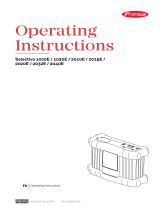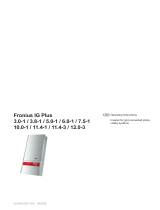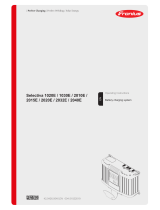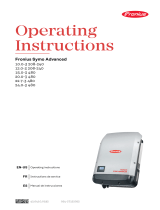5
EN
Contents
Safety rules ................................................................................................................................................ 7
General ................................................................................................................................................. 7
Proper use ............................................................................................................................................ 7
Environmental conditions...................................................................................................................... 7
Mains connection.................................................................................................................................. 7
Dangers from mains current and charging current ............................................................................... 8
Danger due to acid, gases and vapours ............................................................................................... 8
General information regarding the handling of batteries....................................................................... 8
Protecting yourself and others .............................................................................................................. 9
Safety measures in normal operation ................................................................................................... 9
EMC Device Classifications.................................................................................................................. 9
EMC measures ..................................................................................................................................... 9
Data protection...................................................................................................................................... 9
Maintenance and repair ........................................................................................................................ 10
Obligations of the operator.................................................................................................................... 10
Safety inspection................................................................................................................................... 10
Safety symbols...................................................................................................................................... 10
Disposal ................................................................................................................................................ 10
Copyright............................................................................................................................................... 11
General information ................................................................................................................................... 12
Device concept ..................................................................................................................................... 12
Proper use ............................................................................................................................................ 12
Mains connection.................................................................................................................................. 13
Charging lead........................................................................................................................................ 13
Correct arrangement of the mains/charging leads................................................................................14
Warning notices on the device.............................................................................................................. 15
Warning notices inside the device ........................................................................................................ 16
Setup regulations.................................................................................................................................. 16
Wall and floor bracket ........................................................................................................................... 18
Control elements and connections............................................................................................................. 20
General ................................................................................................................................................. 20
Controls and connections ..................................................................................................................... 20
Control panel......................................................................................................................................... 22
Charging the battery .................................................................................................................................. 24
Charging ............................................................................................................................................... 24
Interrupting charging............................................................................................................................. 26
Stopping charging................................................................................................................................. 27
Display ....................................................................................................................................................... 28
Overview of modes ............................................................................................................................... 28
Standard mode ..................................................................................................................................... 29
Menu selection...................................................................................................................................... 29
Statistics mode...................................................................................................................................... 30
History mode......................................................................................................................................... 31
Configuration mode............................................................................................................................... 31
Settings................................................................................................................................................. 36
Additional functions............................................................................................................................... 42
General options..................................................................................................................................... 44
Reset settings ....................................................................................................................................... 45
USB mode............................................................................................................................................. 45
Status codes ......................................................................................................................................... 47
Options....................................................................................................................................................... 50
Safety.................................................................................................................................................... 50
Electrolyte circulation 3 kW................................................................................................................... 50
External start/stop................................................................................................................................. 52
Temperature-controlled charging.......................................................................................................... 52
LED strip ............................................................................................................................................... 52
Air filter.................................................................................................................................................. 53
Wall and floor bracket ........................................................................................................................... 53
"Mobile" kit ............................................................................................................................................ 53





























